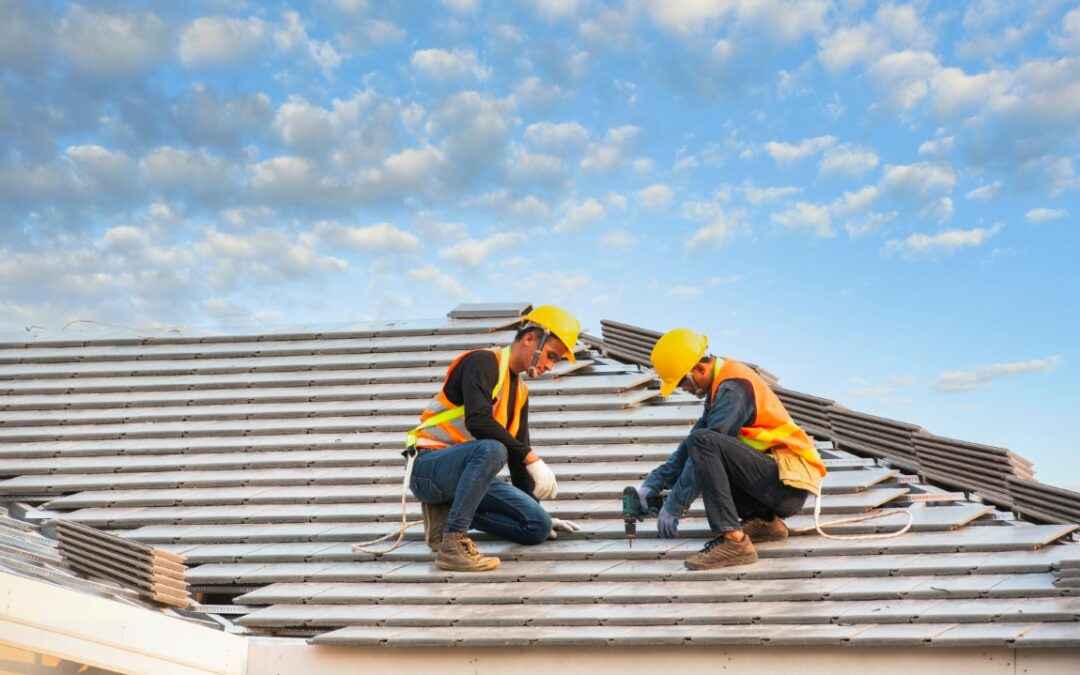Welcome to our guide on picking the right roof installation materials! In this article, we’ll break down the different types of roofing materials, factors to consider when choosing the right one, and popular options in the market. We’ll also discuss the pros and cons of each material, durability and longevity factors, cost considerations, and eco-friendly options.
So, whether you’re looking for durability, affordability, or sustainability, we’ve got you covered! Join us as we navigate through the world of roof installation materials together.
Key Takeaways
- Consider the budget, aesthetics, and climate conditions when choosing between metal, shingle, or synthetic roofing materials.
- Balance the cost and durability of roofing materials to make an informed decision.
- Take into account the climate suitability of the materials to ensure they can withstand extreme weather conditions.
- Follow the recommended maintenance schedule to extend the lifespan of the roof and consult with a roofing professional for expert advice.
Types of Roofing Materials
When choosing the right roof installation materials, it’s important to consider the various types of roofing materials available.
One key decision is whether to go with metal or shingle roofing. Metal roofs are known for their durability and longevity. They can withstand extreme weather conditions and require minimal maintenance.
On the other hand, shingle roofs offer a more traditional look and are available in a wide range of styles and colors. They’re also more cost-effective compared to metal roofs.
Another option to consider is synthetic roofing materials. These materials mimic the appearance of natural materials like slate or wood but offer greater durability and resistance to weathering. Synthetic options provide a balance between aesthetics and functionality, making them a popular choice among homeowners.
Ultimately, the choice between metal, shingle, or synthetic roofing materials depends on factors such as budget, desired aesthetics, and climate conditions.
Factors to Consider in Material Selection
When selecting the right roofing materials, several factors need to be considered.
One important factor is the cost versus durability. It’s crucial to find a balance between the initial cost of the materials and their ability to withstand the test of time.
Another factor to consider is the climate suitability. Different materials have different strengths and weaknesses when it comes to withstanding extreme weather conditions.
Lastly, the maintenance requirements of the materials should also be taken into account. Some materials may require more regular maintenance and repairs, while others are more low maintenance.
Cost Vs. Durability
Considering the cost versus durability of different roofing materials is crucial in selecting the right option for our project. When evaluating the cost-effectiveness of roofing materials, it’s important to take into account their lifespan as well. Some materials may have a lower upfront cost but require more frequent repairs or replacement, ultimately increasing the overall cost in the long run.
On the other hand, investing in more durable materials may seem expensive initially but can result in significant savings over time due to their longer lifespan and reduced maintenance needs. By carefully comparing the cost and durability of different roofing materials, we can make an informed decision that balances our budget with the longevity and performance of the chosen material.
Now, let’s move on to the next section, which discusses the importance of considering climate suitability when selecting roofing materials.
Climate Suitability
To ensure the right roofing material is selected, it’s important to consider climate suitability and the factors that impact material selection.
Climate plays a crucial role in determining the lifespan of roofing materials and their impact on energy consumption. Different climates have varying levels of temperature, humidity, and precipitation, which can affect the durability and performance of the roof.
For example, in hot and sunny climates, materials with high heat resistance and UV protection are essential to prevent cracking and color fading. In colder climates, materials that can withstand freezing temperatures and heavy snow loads are preferable.
Additionally, the choice of roofing material can also impact energy consumption. Reflective materials can help reduce heat absorption and lower cooling costs in warmer climates, while insulation materials can improve energy efficiency and reduce heating costs in colder climates.
Considering these climate factors will ensure that the selected roofing material is suitable for the specific environmental conditions, enhancing its longevity and optimizing energy consumption.
Maintenance Requirements
Maintenance requirements play a significant role in the selection of roofing materials. When choosing the right material for your roof, it’s important to consider the lifespan of the material and the recommended maintenance schedule. Different roofing materials have varying levels of durability and require different maintenance routines to ensure their longevity.
The lifespan of a roofing material is an essential factor to consider. Some materials, like metal and slate, have a longer lifespan compared to asphalt shingles. By understanding the expected lifespan of a material, you can plan and budget for future maintenance and replacement needs.
In addition to lifespan, it’s crucial to consider the recommended maintenance schedule for each roofing material. Some materials may require regular inspections, cleanings, or treatments to prevent damage and ensure optimal performance. By following the recommended maintenance schedule, you can extend the lifespan of your roof and avoid costly repairs.
Considering the roofing material’s lifespan and recommended maintenance schedule will help you choose the right material that suits your budget, preferences, and maintenance capabilities. It’s always best to consult with a roofing professional to get expert advice and guidance in selecting the most suitable roofing material for your specific needs.
Popular Roofing Material Options
We have found several popular roofing material options that are worth considering for your roof installation. When it comes to choosing between metal and shingles, both have their advantages.
Metal roofs are known for their durability and longevity, while shingles offer a more traditional look and are easier to install. Additionally, there are energy-efficient options available in both categories.
Metal roofs can be coated with reflective materials, helping to reduce heat absorption and lower cooling costs. Shingles, on the other hand, can be made with solar-reflective granules that reflect sunlight and reduce heat transfer into the home.
Considering these options can help you make an informed decision about the best roofing material for your needs. Now, let’s explore the pros and cons of different materials.
Pros and Cons of Different Materials
Let’s weigh the pros and cons of various roofing materials to help you make an informed decision. When it comes to choosing the right material for your roof, it’s important to consider the advantages and disadvantages of each option.
One popular roofing material is asphalt shingles. They’re affordable, easy to install, and come in a variety of colors. However, they may not be as durable as other materials and may require more maintenance over time.
Another option is metal roofing. It’s known for its durability, energy efficiency, and long lifespan. However, it can be more expensive upfront and may require professional installation.
Tile roofing is a great choice for those looking for a stylish and long-lasting option. It’s resistant to fire, insects, and rot. However, it can be heavy and may require additional structural support.
Lastly, wood shakes provide a natural and rustic look. They’re eco-friendly and offer good insulation. However, they’re prone to rot, mold, and pests.
When selecting the right roofing material for your home, consider your budget, climate, and desired aesthetic. It’s always a good idea to consult with a professional to ensure you make the best choice for your specific needs.
Durability and Longevity of Roofing Materials
One important factor to consider when choosing roofing materials is the expected lifespan and durability of each option. It’s crucial to select materials that offer long-term performance and can withstand various weather conditions.
Some materials, like asphalt shingles, have an average lifespan of 20-30 years, while others, such as metal or slate, can last 50 years or more. Metal roofs are known for their durability and impact resistance, making them a popular choice for areas prone to severe weather or falling debris.
Slate roofs, on the other hand, are incredibly durable and can last over a century with proper maintenance. When weighing the options, it’s important to consider the long-term performance and impact resistance of each material to ensure a sturdy and long-lasting roof.
Cost and Budget Considerations
When considering roofing materials, it’s essential to factor in the cost and budget considerations associated with each option. Average installation costs can vary significantly depending on the type of material chosen.
While asphalt shingles tend to be the most affordable option, materials like metal or slate can be more expensive upfront. However, it’s important to also consider the long-term cost analysis. While cheaper materials may require more frequent repairs or replacements, more durable options can provide better value over time.
Additionally, energy-efficient materials, such as metal roofing with reflective coatings, can help save on heating and cooling costs in the long run.
Eco-Friendly Roofing Material Options
We can explore eco-friendly roofing material options by considering their sustainability and environmental impact.
When it comes to sustainable roofing options, there are several materials to consider. One popular choice is metal roofing, which is highly durable and can last for decades, reducing the need for frequent replacements. Metal roofs are also recyclable at the end of their lifespan.
Another option is clay or concrete tiles, which are made from natural and abundant materials. These tiles have a long lifespan and can be recycled or repurposed.
Additionally, there are eco-friendly shingles made from recycled materials such as plastic or rubber. These shingles offer excellent durability and energy efficiency.
Conclusion
In conclusion, choosing the right roof installation materials is crucial for the longevity and durability of your roof. Consider factors such as cost, durability, and eco-friendliness when making your decision.
Each material has its pros and cons, so it’s important to weigh them carefully. Symbolically, the roof represents protection and security for your home, and selecting the right materials ensures that it remains strong and reliable for years to come.

